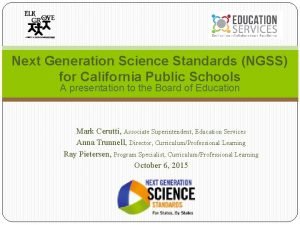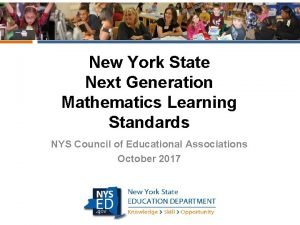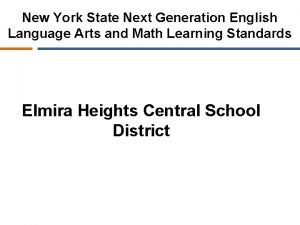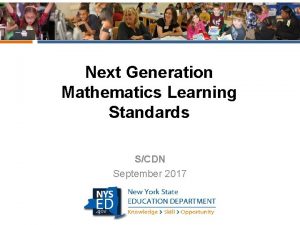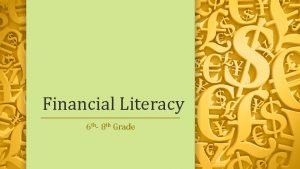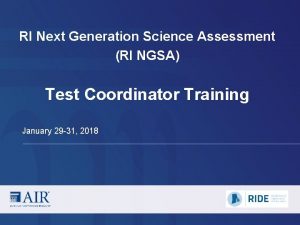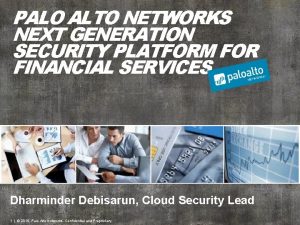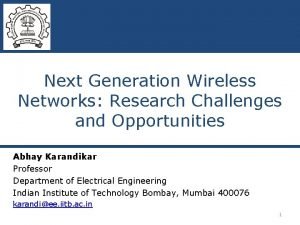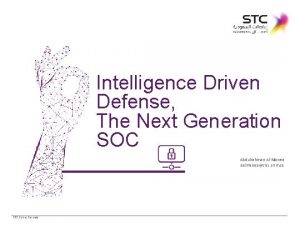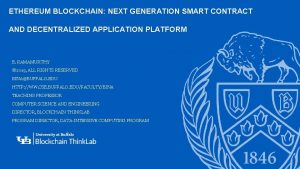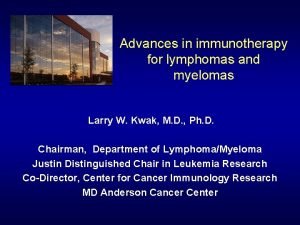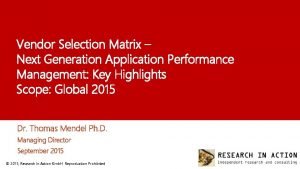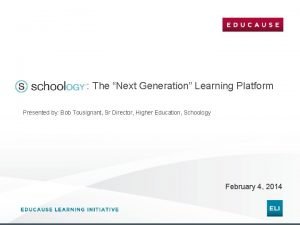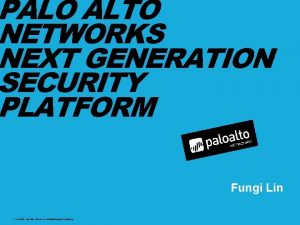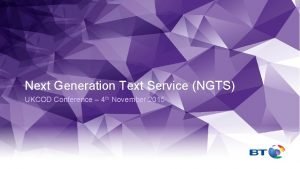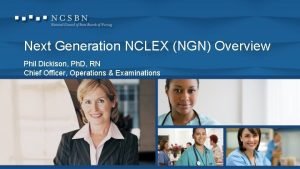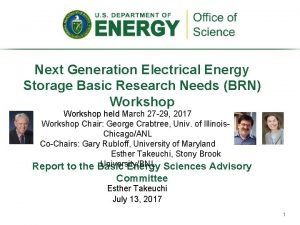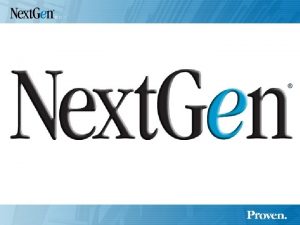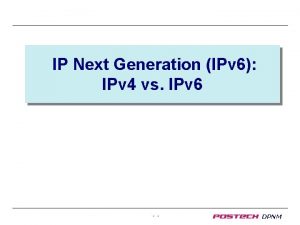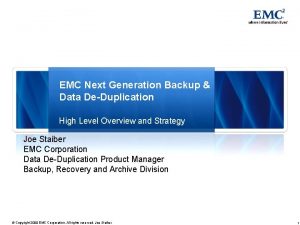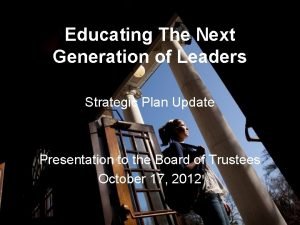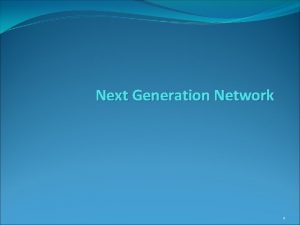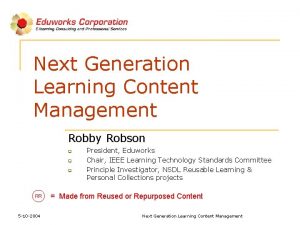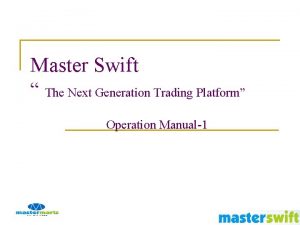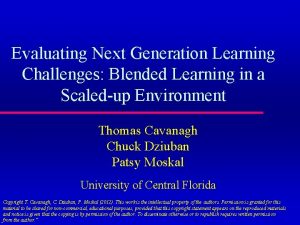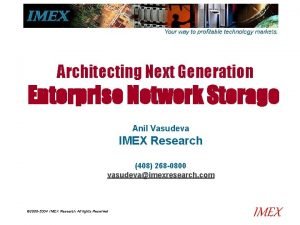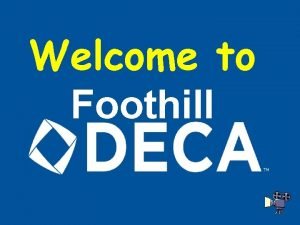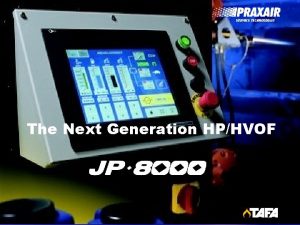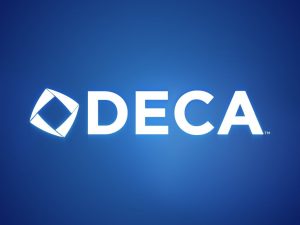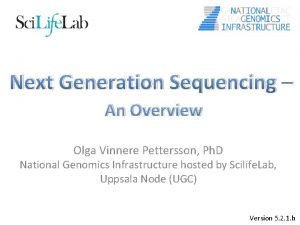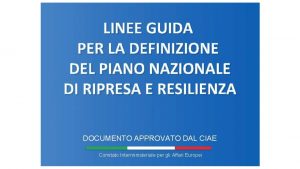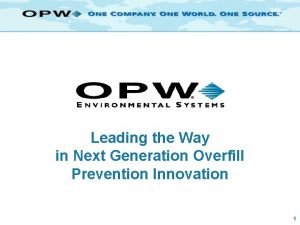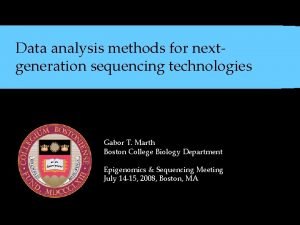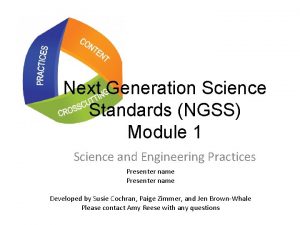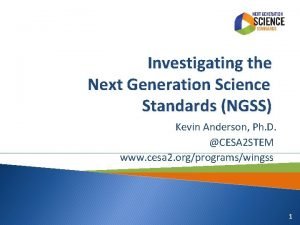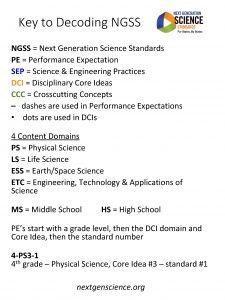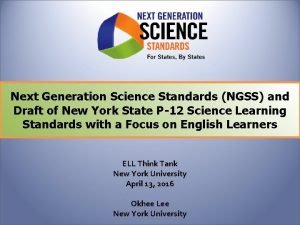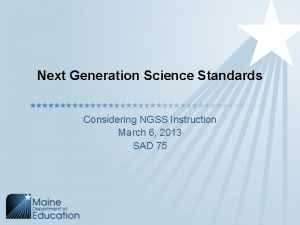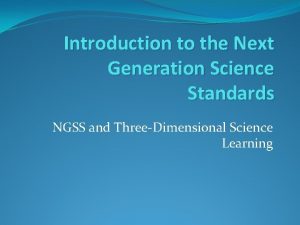Planning for Next Generation Science Standards NGSS 1





































- Slides: 37

Planning for Next Generation Science Standards (NGSS) 1

2

3

*A Framework for K-12 Science Education: Practices, Crosscutting Concepts, and Core Ideas (NRC 2011) http: //www 7. nationalacademies. org/bose/Standards_Framework_Ho mepage. html * Common Core Standards for English/language arts and Literacy in History/Social Studies, Science, and Technology (CCSS 2011) Common Core State Standards for Mathematics (CCSS 2011) http: //www. corestandards. org/the-standards * Arkansas Science Curriculum Frameworks (ADE 2005) http: //www. arkansased. org/educators/curriculum/frameworks. html * Status of Science Standards 1 -pager * Crosscutting Concepts Table * ELA/Math/Science Practices Table * How to Read the Standards * Education Acronyms List 4

How is Arkansas Involved in the development of the NGSS? Writing Team Only Lead State Partner and Writing Team 5 Achieve Inc. , 2011

Development of NRC A Framework for K-12 Science Education and the Next Generation Science Standards (NGSS) Framework for K – 12 Science Education: Practices, Crosscutting Concepts, and Core Ideas funderstanding. com • Scientific community through the National Academy of Sciences provides key leadership in development Next Generation Science Standards (NGSS) • States and educators provide key leadership in the development. 6

Assessment Curricula Instruction Teacher development 7 Achieve Inc. , 2011

BACKGROUND RESEARCH & PRACTITIONERS GUIDES 8

PART I: A Vision for K-12 Science Education § Introduction § Guiding Assumptions and Organization of the Framework PART II: Dimensions of the Framework § Scientific and Engineering Practices § Crosscutting Concepts § Disciplinary Core Ideas Part III: Realizing the Vision § Engineering, Technology, and Applications of Science § Integrating the Three Dimensions § Implementation § Equity and Diversity § Guidance for Standards 9 Development

The main goal of the Framework is to ensure that by the end of high school all students have some appreciation of science, the ability to discuss and think critically about science-related issues, and the skills to pursue careers in science or engineering. ~Brian Reiser (2011) 10

NRC Framework is designed to realize a vision of science education in which ALL students’ experiences over multiple years foster progressively deeper understanding of science. www. dailygalaxy. com 11

PART I: A Vision for K-12 Science Education § Introduction § Guiding Assumptions and Organization of the Framework PART II: Dimensions of the Framework § Scientific and Engineering Practices § Crosscutting Concepts § Disciplinary Core Ideas Part III: Realizing the Vision § Engineering, Technology, and Applications of Science § Integrating the Three Dimensions § Implementation § Equity and Diversity § Guidance for Standards Development 12

Refer to Chapter 1(first two pages) Take a few moments to read the vision of the Framework. Turn to the educator next to you and discuss the following questions: 1. What are the goals of this conceptual “framework”? 2. How do these goals relate to the goals of the science program in your district? 13

Guiding Assumptions and Organization of the Framework Skim the bold headings throughout Chapter 2. 1. What assumptions did they make about how children learn science? 2. How and why are the frameworks structured? 14

Practices Three Dimensions of the Framework for K-12 Science Education Next Generation Science Standards Crosscutting Concepts Core Ideas 15

PART I: A Vision for K-12 Science Education § Introduction § Guiding Assumptions and Organization of the Framework PART II: Dimensions of the Framework § Scientific and Engineering Practices § Crosscutting Concepts § Disciplinary Core Ideas Part III: Realizing the Vision § Engineering, Technology, and Applications of Science § Integrating the Three Dimensions § Implementation § Equity and Diversity § Guidance for Standards Development 16

Refer to Chapter 3 pgs. 43 -46 (PDF pgs. 57 -63). Read and Reflect on the following questions: 1. Why are “practices” emphasized instead of “inquiry”? 2. How are practices integrated into both inquiry and design? 3. What is different about how you teach science and how scientists work? 17

1. Asking questions (science) and defining problems (engineering) 2. Design and using models 3. Planning and carrying out investigations 4. Analyzing and interpreting data 5. Using mathematics and computational thinking 6. Developing explanations (science) and designing solutions (engineering) 7. Engaging in argument 8. Obtaining, evaluating, and communicating information 18

What is different about the role of each practice’s manifestation in science with its counterpart in engineering? * * See Table 3 -2 page 50 Note that in doing science or engineering, the practices are used iteratively and in combination; they are not linear steps to be taught in order (pg. 49) 19

Analysis of ELA/Math/Science Practices ELA Capacities Mathematical Practices Scientific and Engineering Practices Demonstrate independence Make sense of problems and persevere in solving them Asking questions (for science) and defining problems (for engineering) Build strong content knowledge Reason abstractly and quantitatively Developing and using models Respond to the varying demands of audience, task, purpose, and discipline Construct viable arguments and critique the reasoning of others Planning and carrying out investigations Comprehend as well as critique Model with mathematics Analyzing and interpreting data Value evidence Use appropriate tools strategically Using mathematics, information and computer technology, and computational thinking Use technology and digital media strategically and capably Attend to precision Constructing explanations (for science) and designing solutions (for engineering) Come to understand other perspectives and cultures Look for and make use of structure Engaging in argument from evidence Look for and express regularity in repeated reasoning Obtaining, evaluating, and communicating information ELA (pg. 7) http: //www. corestandards. org/assets/CCSSI_ELA%20 Standards. pdf Mathematics (pgs. 6 -8) http: //www. corestandards. org/assets/CCSSI_Math%20 Standards. pdf 20

1. Patterns 2. Cause and effect: Mechanism and explanation 3. Scale, proportion, and quantity 4. Systems and system models 5. Energy and matter: Flows, cycles, and conservation 6. Structure and function 7. Stability and change nanobioart. com 21

Refer to Chapter 4 Crosscutting Concepts Summary Page 84 (PDF pg. 98) nanobioart. com 22

Refer to the K-12 Core Ideas in A Framework for K-12 Science Education q Physical Sciences (Chapter 5, Pg. 103/PDF pg. 118) q Life Sciences (Chapter 6, Pg. 139/ PDF pg. 154 ) q Earth and Space Sciences (Chapter 7, Pg. 169/PDF pg. 184 ) q Engineering, Technology, and Applications of Science (Chapter 8, Pg. 201/ PDF pg. 216) 23

q. Core Idea PS 1: Matter and Its Interactions (Book pg. 106) q. Core Idea PS 2: Motion and Stability: Forces Interactions (Book pg. 113) and q. Core Idea PS 3: Energy (Book pg. 120) q. Core Idea PS 4: Waves and Their Applications in Technologies for Information Transfer (Book pg. 130) 24

q. Core Idea LS 1: From Molecules to Organisms: Structures and Processes (Book pg. 143) q. Core Idea LS 2: Ecosystems: Interactions, Energy, and Dynamics (Book pg. 150) q. Core Idea LS 3: Heredity: Inheritance and Variation of Traits (Book pg. 157) q. Core Idea LS 4: Biological Evolution: Unity and Diversity (Book pg. 161) 25

q. Core Idea ESS 1: Earth’s Place in the Universe (Book pg. 173) q. Core Idea ESS 2: Earth’s Systems (Book pg. 179) q. Core Idea ESS 3: Earth and Human Activity (Book pg. 190) 26

q. Core Idea ETS 1: Engineering Design (Book pg. 204) q. Core Idea ETS 2: Links Among Engineering, Technology, Science, and Society (Book page 210) 27

Some Big Shifts in the Core and Sub-Core Ideas Earth and Human Activity • Global Climate Change • Human Impacts on Earth Systems Biological Evolution: Unity and Diversity • Evidence of Common Ancestry and Diversity • Natural Selection Waves and Their Applications in Technologies for Information Transfer • Wave Properties • Information Technologies and Instrumentation Earth’s Place in the Universe • The Big Bang • The History of Planet Earth 28

Appendix E- DCI Progressions with NGSS * Tomorrow we will look closer at these to see what changes in content to expect IF we adopt NGSS in Arkansas. 29

PART I: A Vision for K-12 Science Education § Introduction § Guiding Assumptions and Organization of the Framework PART II: Dimensions of the Framework § Scientific and Engineering Practices § Crosscutting Concepts § Disciplinary Core Ideas Part III: Realizing the Vision § Integrating the Three Dimensions § Implementation § Equity and Diversity § Guidance for Standards Development § Looking Toward the Future 30

Through a collaborative, state-led process, new K– 12 science standards are being developed that will be rich in content and practice, arranged in a coherent manner across disciplines and grades to provide all students an internationally benchmarked science education. The NGSS will be based on the Framework for K– 12 Science Education developed by the National Research Council. 31 thedailygreen. com

Science and Engine ering P ractices Di s Co cipl re ina Ide ry as g ttin u c ss ts o r C cep n Co 32 Achieve Inc. , 2011

Core Ideas Crosscutting Concepts Practices Next Generation Science Standards 33 Moulding, BCSSE, 2011

Sign Up! http: //www. nextgenscience. org/ 34

35

The intent of the Framework is to change how we teach science so that it is more like how scientists work. *How does this compare to your current teaching practice? *Will a big shift be necessary in your class or curriculum? *What questions do you have? * 36

1. 2. 3. 4. Achieve Inc. “Developing for Next Generation Science Standards. ” Achieve Inc. Power. Point presentation. January 2012. Molding, Brett. Vision for Science Education A Framework for K-12 Science Education: Practices, Crosscutting Concepts, and Core Ideas. Professional development BCSSE workshop. Power. Point presentation. 2011. National Research Council (NRC). 2012. A Framework for K-12 Science Education: Practices, Crosscutting Concepts, and Core Ideas. Washington, DC: National Academies Press. Sherman, M. (2011). “Brian Reiser on expert panel that issues new science education framework. ” Northwestern School of Education and Social Policy. Available on-line at http: //www. sesp. northwestern. edu/newscenter/news/2011/07/reiser-nrc-report-scienceframework. html. 37
 Next generation science standards california
Next generation science standards california X.next = x.next.next
X.next = x.next.next Next gen math standards
Next gen math standards Nys ela standards
Nys ela standards Financial literacy grade 9
Financial literacy grade 9 Nys next generation math standards
Nys next generation math standards Financial literacy grade 8
Financial literacy grade 8 Ngsa testing
Ngsa testing First gen antipsychotics
First gen antipsychotics You are good and your mercy
You are good and your mercy Palo alto traps gartner
Palo alto traps gartner Next generation wireless communication market
Next generation wireless communication market Ncsbn clinical judgement model
Ncsbn clinical judgement model Intelligence driven defense
Intelligence driven defense Blaockchain
Blaockchain Vaccine therapy
Vaccine therapy Vendor analysis matrix
Vendor analysis matrix Next generation lms
Next generation lms Sinkhole palo alto
Sinkhole palo alto What is next generation text service
What is next generation text service Next generation nclex
Next generation nclex Electrical energy
Electrical energy Next gen emr
Next gen emr Ip next generation
Ip next generation Next generation backup
Next generation backup Educating the next generation of leaders
Educating the next generation of leaders Next generation network adalah
Next generation network adalah Robby robson
Robby robson Next generation trading
Next generation trading Next generation learning challenges
Next generation learning challenges Anil vasudeva
Anil vasudeva What does deca prepare the next generation to be
What does deca prepare the next generation to be The next generation
The next generation Deca prepares the next generation to be
Deca prepares the next generation to be Craig wenter
Craig wenter Struttura pnrr
Struttura pnrr The next generation
The next generation Next generation sequencing methods
Next generation sequencing methods
